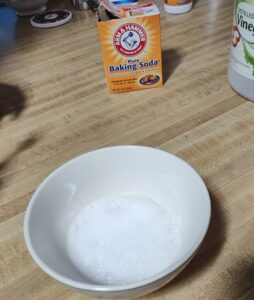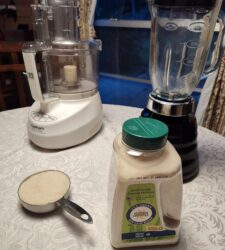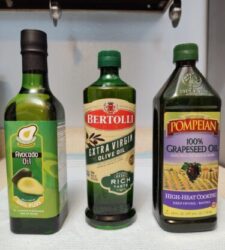Substitute Sparkling Water and Baking Soda in lieu of Baking Powder and Cream of Tartar
Use Baking Soda with an acidic as a leavening agent for baking or breads. You must use baking soda along with an acidic like lemon juice, honey, milk or buttermilk, or brown sugar, molasses, yogurt, applesauce natural cocoa powder (don’t use Dutch processed) to react with the baking soda to create the carbon dioxide needed to allow your dough or dessert to rise. This will replace the cream of tartar and the baking powder in your recipe. Which is mandatory if you are baking for someone with an egg allergy.
Made of sodium acetate, Baking Soda must be wet and mixed with something acidic to activate the carbon dioxide bubbles needed to allow the rise of bread dough and baked goods. It is important to note that once you add the ingredients together don’t delay getting it to the oven as the carbon dioxide bubbles will dissipate.
Baking Soda is 3 to 4 times stronger than baking powder. If you add to much baking soda, there will be a bitter aftertaste. Don’t add more than ¼ teaspoon per cup of flour or you will have a bitter after taste.
Test Baking Soda for Freshness
If you have an opened box of Baking Soda the freshness can expire. A simple test for freshness prior to adding to your recipe should be done.
Pour 3 tablespoons of white distilled vinegar into a small bowl. Add ½ teaspoon of baking soda. The mixture should immediately start bubbling rapidly if the soda is fresh. If there is no reaction, toss it and buy a new package.

Baking Soda Measurements vs Flour
Baking Soda Flour
1/16 teaspoon ¼ cup
1/8 teaspoon ½ cup
¼ teaspoon 1 cup
½ teaspoon 2 cups
¾ teaspoon 3 cups
Sparkling Water can be used to give doughs and batters lift.
The carbon dioxide in sparkling water creates bubbles and lowers the pH making it slightly acidic. The bubbles start to dissipate once exposed to oxygen and disappear when mixed with flour. If you add lemon juice it will recreate the effects of sparkling water in baking.
The ratio is 1 tablespoon of lemon juice in 1 cup of bottled water for every cup of sparkling water needed in a recipe.
Where Cream of Tartar comes from
Some Winemakers add egg whites in the cask to activate the fermenting process. Winemaking byproduct known as Cream of Tartar. The result of this can cause an allergic reaction for egg allergy people.
The potassium bitartrate crystals were first discovered inside the remains of a wine making container in the ruins of an ancient village in northern Iran around 7,000 years ago. Today, potassium bitartrate crystals are used in cooking and is known as Cream of Tartar.
Grapes are a natural source of cream of tartar’s main ingredient: tartaric acid. When the grapes sit inside the casks and ferments it creates potassium bitartrate crystals inside of the casks which is then collected and processed to make cream of tartar. This process allows a winemaker to get the wine to market sooner. It is better for people who are allergic to eggs to use a substitute for cream of tartar. Because baking powder has cream of tartar in the mix it is not good solution for people with egg allergies. Cook/Chefs use cream of tartar to stabilize whipped egg whites in meringues and prevents sugar crystallization in candies and caramel.
Baking Powder contains Baking Soda and Cream of Tartar
It is the cream of tartar that has the possibility of egg whites as an ingredient. Baking powder is 2 parts cream of tartar and 1 part baking soda. So, 2/3 of each teaspoon of baking powder is cream of tartar. An egg allergy nightmare.


